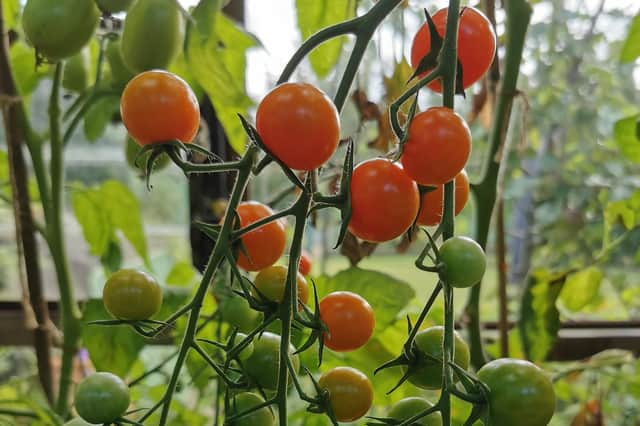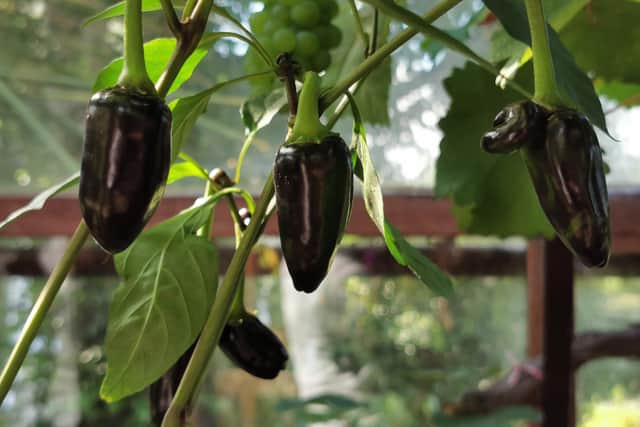Tomatoes continue to be off shopping list


There are distinct differences in flavour between cultivars. In keeping with potatoes which belong to the same Solanaceae family, the fruits of this vegetable differ according to the palate of the consumer.
We grow two main types of tomato; the traditional, medium sized (‘Shirley’, ‘Ailsa Craig’, ‘Roma’ and ‘Black Russian’) which are sliced for sandwiches or salads, and those of cherry proportion (‘Gardeners’ Delight’, ‘Sungold’, ‘Sweet Million’ and ‘Aviditas’). It is the latter group that provide the impromptu treat.
Advertisement
Hide AdAdvertisement
Hide AdA taste test, which I did recently to determine the sweetest, was not terribly helpful. They were all so close. For this reason, those considered to be the top four were on the original seed list. What I can confirm is that grafted cultivars, although more expensive to buy, offer greater vigour and production than those raised from seed. Three plants of ‘Aviditas’ ordered online, have developed outstanding trusses. We’ll certainly grow it again next year.


Meanwhile, tomatoes are absent from the weekly shopping list. If they’re required for salad or to join cheese in a lunchtime sandwich, it’s a small walk to the greenhouse. As I view the substantial crop, the vines on which they hang are a far cry from fresh, green-leafed foliage of mid-June. Most of the leaves have gone, removed by this fellow, and ripening fruits dangle from bare stems.
There are often several routes to success in gardening and tomato growing is no different. My well-tried process involves placing young plants in their final large pots, on the surface of the greenhouse border in May. Each has a large cane in place for support and pot watering as required, continues until the middle of June by which time fruits are formed on first trusses and roots have penetrated the soil below. That’s when the border is watered daily, and a weekly feed added.
As the tomatoes develop the process of removing lower leaves begins. This allows light and air to circulate, discouraging fungal disease whilst encouraging ripening. By late August, the crop is in full view.
PLENTY OF TREATS IN A GREENHOUSE
Advertisement
Hide AdAdvertisement
Hide AdSweet cherry tomatoes are not the only treat a greenhouse can hold in store. Just as the last few peaches are plucked from the tree, a mini cucumber remains in full production, chilli peppers are developing and first of the grape harvest is ripening.
The cucumber is an F1 hybrid ‘Baby’ which offers a constant stream of fruits up to 15 centimetres long and is disease resistant. It has been so productive that the kitchen is overrun with its fruits. Anyone who struggles to grow these cucurbits from seed, because they can be tricky in the wrong environment, should try a grafted type such as this whose sheer vigour almost guarantees success.
Sweet and chilli peppers also occupy our summer greenhouse. They’re grown in pots as annuals which are consigned to the composting facility at the season’s end. If you’re starting them from seed, it’s best to begin early in the year. The alternative is to buy a potted specimen with developing fruits as they appear at the garden centre.
They revelled in warm conditions such as those experienced in July but are prone to fungal attack when cooler days coincide with an over-moist compost. Currently, whereas we have a ‘Hungarian Black’ chilli laden with peppers, the ‘Hot Lemon’ and ‘Carolina Reaper’ are slow in producing them. This prompts me to offer both a stimulus of the warmer conservatory.
Advertisement
Hide AdAdvertisement
Hide AdExcitement grows as the first of two grape varieties starts to ripen. Given careful, daily attention the harvesting will continue deep into November.
This entails checks for the discolouration of individual fruits which, removed in time, prevents the domino effect in a large bunch.
Maximum daytime ventilation of the whole greenhouse or polytunnel is essential when there are so many precious fruits at stake!